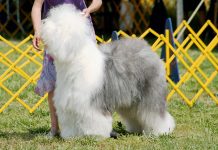History and Origins of the Tibetan Spaniel Breed

The Tibetan Spaniel is an ancient breed with a rich history originating from the Himalayan region of Tibet. Here’s an overview of the history and origins of the Tibetan Spaniel:
- Ancient Heritage: Tibetan Spaniels are believed to have been bred by Buddhist monks in monasteries of Tibet over 2,000 years ago. They were highly revered as companions and watchdogs.
- Monastery Guardians: Tibetan Spaniels were kept by Tibetan monks and served as watchdogs in monasteries, where they would sit on walls and alert the monks to approaching strangers or animals.
- Sacred Status: The breed was considered sacred and was often given as gifts to visiting dignitaries or as tokens of good luck. They were not sold but rather presented as cherished gifts.
- Development of the Breed: Tibetan Spaniels were selectively bred by Tibetan monks to preserve their unique characteristics, including their keen intelligence, alertness, and adaptability to the harsh mountain climate.
- Importation to the West: Tibetan Spaniels were brought to England and other parts of Europe by travelers and explorers in the late 19th century. They quickly gained popularity as exotic and charming companions.
- Recognition: The breed was officially recognized by the American Kennel Club (AKC) in 1983 under the Non-Sporting Group.
Today, Tibetan Spaniels are cherished as delightful and affectionate companions around the world, maintaining their unique heritage and endearing traits.
Physical Characteristics and Appearance of Tibetan Spaniels
Tibetan Spaniels are a small and sturdy breed known for their distinctive appearance and charming personality. Here are the key physical characteristics and appearance traits of Tibetan Spaniels:
- Size: Tibetan Spaniels are small-sized dogs with a compact and well-balanced build. They typically stand between 9 to 10 inches (23 to 25 cm) at the shoulder and weigh around 9 to 15 pounds (4 to 7 kg).
- Head: They have a distinctive domed head with a short, blunt muzzle. The expression is alert, intelligent, and expressive.
- Eyes: Tibetan Spaniels have large, dark eyes that are set well apart. Their eyes convey a gentle and introspective expression.
- Ears: The ears are pendant (hanging down) and set medium-high on the head. They are feathered with long hair, adding to the breed’s charming appearance.
- Coat: Tibetan Spaniels have a double coat consisting of a soft, silky undercoat and a longer, dense outer coat. The coat is straight or slightly wavy and comes in various colors, including shades of gold, cream, red, black, and sable.
- Tail: The tail is set high and carried over the back in a graceful curve. It is well-feathered with dense hair, adding to the breed’s elegant appearance.
- Gait: Tibetan Spaniels have a smooth, flowing gait with good reach and drive. They move with a confident and dignified demeanor.
- Overall Appearance: Tibetan Spaniels are known for their regal and noble appearance, combined with an affectionate and charming personality. They have a compact yet sturdy build, ideal for both indoor living and outdoor activities.
Tibetan Spaniels make excellent companions for individuals or families looking for a small yet resilient dog with a rich history and captivating personality. Their unique appearance, combined with their loyal and loving nature, has endeared them to dog lovers around the world.
Tibetan Spaniel Temperament and Personality Traits
Tibetan Spaniels are delightful companions known for their affectionate nature, intelligence, and independent spirit. Understanding their temperament and personality traits is essential for providing them with proper training and socialization. Here are the key characteristics of Tibetan Spaniels:
- Affectionate and Loyal:
- Tibetan Spaniels form strong bonds with their families and are very affectionate towards their owners. They enjoy spending time with their human companions and are often referred to as “velcro dogs” due to their desire to be close to their family members.
- Intelligent and Alert:
- Tibetan Spaniels are intelligent dogs with a keen sense of awareness. They are quick learners and enjoy mental stimulation such as interactive games, puzzle toys, and obedience training.
- Independent Thinkers:
- Despite their small size, Tibetan Spaniels are independent dogs with a strong sense of self. They can be somewhat stubborn at times and may require patient and consistent training.
- Gentle and Calm:
- This breed is known for its gentle and calm demeanor. They are well-suited for apartment living and enjoy relaxing indoors with their families.
- Watchful and Protective:
- Tibetan Spaniels have a natural instinct to be watchful and alert. They make excellent watchdogs and will alert their owners to any approaching strangers or unusual noises.
- Good with Children and Other Pets:
- Tibetan Spaniels are generally good with children, especially if raised with them from a young age. They can also get along well with other dogs and pets in the household, provided they are properly socialized.
- Adaptable to Various Environments:
- Despite their origins in the Himalayas, Tibetan Spaniels adapt well to different living situations. They can thrive in urban or rural settings as long as they receive proper exercise and mental stimulation.
- Reserved with Strangers:
- Tibetan Spaniels tend to be reserved or aloof with strangers. Early socialization is important to help them develop confidence and comfort around unfamiliar people.
- Low to Moderate Energy Level:
- While they enjoy playtime and short walks, Tibetan Spaniels are not overly energetic dogs. They are content to spend quality time with their families indoors.
Training and Socialization Needs for Tibetan Spaniels
Proper training and socialization are essential for shaping a well-behaved and well-adjusted Tibetan Spaniel. Here are some tips for training and socializing your Tibetan Spaniel:
- Start Early:
- Begin training and socialization as soon as you bring your Tibetan Spaniel puppy home. Early exposure to different people, animals, and environments will help them develop into confident adults.
- Positive Reinforcement:
- Use positive reinforcement techniques such as treats, praise, and rewards to motivate and encourage desired behaviors. Tibetan Spaniels respond well to gentle and consistent training methods.
- Basic Obedience Training:
- Teach essential commands such as sit, stay, come, and leave it. Practice these commands regularly to reinforce good behavior and improve communication with your dog.
- Exposure to Various Stimuli:
- Expose your Tibetan Spaniel to different sights, sounds, and experiences to build their confidence and prevent fearfulness. Take them on outings to pet-friendly places and enroll them in puppy classes or obedience training.
- Socialization with People and Pets:
- Encourage positive interactions with people of all ages and other dogs. Arrange playdates with well-behaved dogs to improve their social skills and prevent behavioral issues.
- Consistent Rules and Boundaries:
- Establish consistent rules and boundaries for your Tibetan Spaniel. Be patient and firm in your training approach to reinforce good behavior and discourage unwanted habits.
- Patience and Persistence:
- Tibetan Spaniels can be independent-minded, so patience and persistence are key when training. Keep training sessions short, positive, and enjoyable to keep them engaged and motivated.
By investing time and effort into training and socialization, you can help your Tibetan Spaniel become a well-rounded and well-mannered companion. Positive reinforcement, consistency, and early socialization will contribute to a harmonious relationship and a happy, confident Tibetan Spaniel.
Health Considerations and Common Issues in Tibetan Spaniels

Tibetan Spaniels are generally healthy dogs, but like all breeds, they can be prone to certain health conditions. Understanding these potential issues and providing appropriate care is important for maintaining the health and well-being of your Tibetan Spaniel. Common health considerations include:
- Luxating Patella (Patellar Luxation):
- This condition involves the kneecap (patella) slipping out of its normal position, which can cause lameness and discomfort. In severe cases, surgical correction may be necessary.
- Progressive Retinal Atrophy (PRA):
- PRA is a group of degenerative eye disorders that can lead to vision loss and blindness over time. Regular eye examinations by a veterinary ophthalmologist can help monitor and manage this condition.
- Hip Dysplasia:
- Hip dysplasia is a genetic condition where the hip joint doesn’t develop properly, leading to arthritis and mobility issues. Weight management, moderate exercise, and joint supplements can help alleviate symptoms.
- Portosystemic Shunt (Liver Shunt):
- Some Tibetan Spaniels may be born with a portosystemic shunt, a congenital abnormality where blood bypasses the liver, leading to toxin buildup in the bloodstream. This condition requires surgical intervention.
- Allergies:
- Tibetan Spaniels can develop allergies to environmental factors (e.g., pollen, dust) or certain foods. Symptoms may include itching, skin irritation, and gastrointestinal issues. Identifying and avoiding allergens is important.
- Dental Issues:
- Small breeds like Tibetan Spaniels are prone to dental problems such as dental plaque buildup, gum disease, and tooth decay. Regular dental care, including brushing and dental cleanings, is essential.
- Heart Murmurs:
- Some Tibetan Spaniels may develop heart murmurs, which can indicate underlying heart conditions. Regular veterinary check-ups can help detect and monitor heart health.
- Hypothyroidism:
- Hypothyroidism is a hormonal disorder that can affect metabolism and overall health. Symptoms include weight gain, lethargy, and skin problems. Treatment involves thyroid hormone supplementation.
Living with a Tibetan Spaniel: Suitable Environments and Lifestyle Considerations
Tibetan Spaniels are adaptable dogs that thrive in various living environments, but they have specific needs and preferences that should be considered. Here are some lifestyle considerations for living with a Tibetan Spaniel:
- Indoor Living:
- Tibetan Spaniels are well-suited for indoor living and enjoy being close to their families. They are not typically outdoor dogs and should have access to a comfortable indoor environment.
- Moderate Exercise:
- Provide daily moderate exercise, such as short walks and playtime indoors. Avoid excessive strenuous exercise, especially for young or senior Tibetan Spaniels prone to joint issues.
- Grooming Needs:
- Tibetan Spaniels have a moderate grooming requirement. They have a silky double coat that needs regular brushing to prevent matting and reduce shedding. Trim their nails and clean their ears regularly.
- Socialization and Companionship:
- Tibetan Spaniels thrive on companionship and enjoy spending time with their families. They may become anxious or develop behavioral issues if left alone for long periods. Ensure they receive social interaction and mental stimulation.
- Training and Mental Stimulation:
- Engage your Tibetan Spaniel in training sessions and interactive games to keep their mind sharp and prevent boredom. They excel in obedience training and agility activities.
- Health Monitoring:
- Schedule regular veterinary check-ups to monitor your Tibetan Spaniel’s health and address any concerns promptly. Stay up-to-date with vaccinations, parasite control, and preventive care.
- Child and Pet Interaction:
- Tibetan Spaniels are generally good with children and other pets when properly socialized. Supervise interactions with young children to prevent accidental injuries due to the breed’s small size.
- Comfortable Resting Areas:
- Provide your Tibetan Spaniel with comfortable resting areas, such as a soft bed or cozy crate, where they can relax and unwind.
By understanding the health considerations and lifestyle needs of Tibetan Spaniels, you can create a loving and supportive environment for your beloved companion. Regular veterinary care, proper grooming, socialization, and mental stimulation will contribute to a happy and healthy life for your Tibetan Spaniel.
Tibetan Spaniel Variations and Breeding Practices
Tibetan Spaniels, as a breed, generally have consistent characteristics and appearance traits. However, variations can occur within the breed, especially in terms of coat color and markings. Responsible breeding practices aim to maintain and improve the breed’s health, temperament, and conformation. Here’s an overview of Tibetan Spaniel variations and common breeding practices:
Variations in Tibetan Spaniels:
- Coat Color:
- Tibetan Spaniels come in various coat colors, including:
- Sable: Predominantly golden with black-tipped hairs.
- Red: Solid deep red or shades of light to dark red.
- Black and Tan: Black body with tan markings on the face, chest, and legs.
- Cream: Solid cream or light beige.
- White with Markings: White coat with patches or markings of other colors (e.g., black, red, sable).
- Tibetan Spaniels come in various coat colors, including:
- Markings:
- Tibetan Spaniels may have various markings, such as white markings on the chest, feet, or tip of the tail. Some may exhibit a “mask” pattern on the face, where darker coloration covers the muzzle and eyes.
- Size Variation:
- Tibetan Spaniels typically have a standard size range, but some variations in size may occur within the breed. Breeders may selectively breed for specific size categories, such as “toy” or “miniature” Tibetan Spaniels.
Breeding Practices for Tibetan Spaniels:
- Health Screening:
- Responsible breeders conduct health screenings for genetic conditions common in Tibetan Spaniels, such as patellar luxation, progressive retinal atrophy (PRA), and heart murmurs. Screening helps ensure that breeding pairs are healthy and free from hereditary diseases.
- Temperament and Behavior:
- Good breeders prioritize temperament and behavior when selecting breeding pairs. They aim to produce Tibetan Spaniels with stable, friendly, and well-rounded personalities suitable for companionship.
- Conformation Standards:
- Breeders adhere to conformation standards set by kennel clubs, such as the American Kennel Club (AKC) or the United Kennel Club (UKC). This includes maintaining breed-specific traits and physical characteristics.
- Avoiding Inbreeding:
- Responsible breeders avoid excessive inbreeding to maintain genetic diversity and reduce the risk of inherited health problems. They carefully select breeding pairs to produce healthy and genetically sound puppies.
- Breeding Goals:
- Breeders may have specific goals for their breeding program, such as improving coat color, enhancing temperament, or preserving breed heritage. They tailor breeding practices to achieve these goals while upholding breed standards.
- Ethical Practices:
- Reputable breeders prioritize the well-being of their dogs and puppies, providing proper care, socialization, and veterinary attention. They educate potential puppy buyers about the breed’s characteristics and care requirements.
- Health and Genetic Testing:
- Good breeders utilize health and genetic testing to assess potential breeding dogs for hereditary conditions. This helps ensure that puppies have the best chance of being healthy and free from genetic diseases.
By supporting responsible breeding practices and choosing reputable breeders, you contribute to the preservation and improvement of the Tibetan Spaniel breed. When considering adding a Tibetan Spaniel to your family, seek out breeders who demonstrate a commitment to health, temperament, and breed standards.
50 Best Names with Meanings for Tibetan Spaniels
Choosing the perfect name for your Tibetan Spaniel can be a fun and meaningful process. Here’s a list of 50 great names along with their meanings that could suit your Tibetan Spaniel well:
Male Names:
- Bodhi – Meaning “awakening” or “enlightenment.”
- Kai – Hawaiian name meaning “sea.”
- Loki – Norse god of mischief and trickery.
- Tenzin – Tibetan name meaning “upholder of teachings.”
- Simba – Swahili name meaning “lion.”
- Dexter – Meaning “right-handed” or “skillful.”
- Milo – Derived from the Old Slavic word meaning “merciful.”
- Leo – Latin name meaning “lion.”
- Finn – Irish name meaning “fair” or “white.”
- Cody – English name meaning “helpful.”
- Oscar – Gaelic name meaning “champion warrior.”
- Arlo – Old English name meaning “fortified hill.”
- Hugo – Germanic name meaning “mind” or “intellect.”
- Max – Short for Maximilian, meaning “greatest.”
- Rufus – Latin name meaning “red-haired.”
- Jasper – Persian name meaning “treasurer.”
- Teddy – Short for Theodore, meaning “gift of God.”
- Toby – Hebrew name meaning “God is good.”
- Milo – Latin name meaning “soldier” or “merciful.”
- Benny – Hebrew name meaning “son of my right hand.”
- Gizmo – A term used for a gadget or small machine.
- Winston – Old English name meaning “joy stone.”
- Zeke – Hebrew name meaning “God strengthens.”
- Roscoe – Old Norse name meaning “deer forest.”
- Walter – Germanic name meaning “ruler of the army.”
Female Names:
- Luna – Latin name meaning “moon.”
- Stella – Latin name meaning “star.”
- Maggie – Short for Margaret, meaning “pearl.”
- Lola – Spanish name meaning “strong woman.”
- Zoe – Greek name meaning “life” or “alive.”
- Coco – Short for Cocoa or Coconut.
- Bella – Italian name meaning “beautiful.”
- Sophie – Greek name meaning “wisdom.”
- Lucy – English name meaning “light.”
- Rosie – Diminutive of Rose, symbolizing love and beauty.
- Mia – Scandinavian name meaning “mine” or “beloved.”
- Daisy – English name referring to the daisy flower.
- Ruby – Precious gemstone symbolizing love and passion.
- Molly – Diminutive of Mary, meaning “bitter” or “beloved.”
- Willow – English name referring to the willow tree.
- Cleo – Short for Cleopatra, meaning “glory of the father.”
- Ginger – Spicy flavoring derived from ginger root.
- Nala – Swahili name meaning “successful” or “beloved.”
- Ivy – English name referring to the ivy plant.
- Lola – Spanish name meaning “sorrows” or “strong woman.”
- Penny – Short for Penelope, meaning “weaver.”
- Misty – Referring to a hazy or foggy appearance.
- Mocha – Referring to the coffee-flavored beverage.
- Hazel – Referring to the hazel tree or eye color.
- Cinnamon – Spice derived from the bark of the cinnamon tree.
Gender-neutral names:
- Charlie – Meaning “free man” or “strong.”
- Sunny – Symbolizing brightness and happiness.
- Riley – Irish name meaning “courageous” or “valiant.”
- Sasha – Short for Alexander or Alexandra, meaning “defender of mankind.”
- Bailey – Referring to a courtyard within castle walls.
- Oreo – Referring to the black and white cookie.
- Sandy – Referring to a beach or golden-colored appearance.
- Peanut – Referring to the edible seed.
- Muffin – Referring to a small, sweet bread.
- Winnie – Short for Winifred or Winston, meaning “joy” or “joy stone.”
Choose a name that resonates with your Tibetan Spaniel’s personality, appearance, or the qualities you admire. Whether you prefer a traditional name with a meaningful origin or a unique and creative name, the right name will be a perfect fit for your beloved companion.

In conclusion, this comprehensive guide to Tibetan Spaniel dogs has provided a detailed overview of this charming and unique breed. Throughout our exploration, we’ve delved into the history, distinctive characteristics, and essential care considerations that define Tibetan Spaniels. Known for their friendly demeanor, intelligence, and loyalty, Tibetan Spaniels make wonderful companions for individuals and families seeking a loving and adaptable pet. They thrive in indoor settings and enjoy spending time with their human companions. As you embark on your journey with a Tibetan Spaniel, may you appreciate their unique qualities and form a strong bond with this delightful breed, creating lasting companionship and joy together.



























